What are dog hot spots?
Dog hot spots, also known as acute moist dermatitis or pyrotraumantic dermatitis, are inflamed skin lesions that can appear suddenly on a dog’s body. They are typically characterized by redness, swelling, oozing, and can be extremely uncomfortable for your furry friend.
Hot spots are an itchy and painful problem for your dog and may become a recurring issue if the underlying condition isn’t treated. Fortunately, with good management, your dog’s hot spot should resolve quickly and will not result in any permanent damage.
What are common causes of hot spots on dogs?
- Allergies: Food, environmental, or skin allergies can trigger excessive scratching, leading to hot spots. Stress or boredom resulting in excessive licking
- Coat that is dirty or matted
- Moisture trapped in the coat
- Insect bites or stings: Fleas, mosquitoes, or other insects can cause irritation.
- Skin irritations: Friction, burns, or chemical exposure.
- Infections: Bacterial or fungal infections.
- Parasites: Fleas, ticks, or mites.
- Matting or tangling: Hair matting can cause skin irritation.
- Ear or skin infections
- Anal sac disease
- Contact irritants
Some breeds such as Golden Retrievers, St. Bernards, Mastiffs, German Shepherd Dogs, Retrievers, Labradoodles, and Rottweilers are susceptible to developing hot spots due to their thicker coats
Supplementing fatty acids is another option to prevent and manage skin disease in dogs. The critical omega-3 fatty acids DHA and EPA are found in fish oil for dogs. These fatty acids not only have anti-inflammatory properties, but they also help promote a healthy skin barrier, making your dog less susceptible to allergens and infections.

Prevention:
- Regular grooming
- Flea and tick control
- Allergy management
- Reduce stress
- Prevent scratching
- Monitor skin health
- Provide home care
If your dog has a hot spot, it’s important to consult a veterinarian for proper diagnosis and treatment. Treatment can help prevent the hot spot from spreading and becoming more severe. Itching, licking, gnawing, and scratching can make the irritation worse, so try to keep your dog from scratching the hot spot. You can use an Elizabethan collar, muzzle, or pet cone substitution to prevent scratching. If the hot spot isn’t infected, you can gently clean the area with a mild soap or antibacterial cleaner and apply a dog safe first-aid cream.
Disclaimer:
This content is for informational purposes only and should not replace professional medical advice. Consult with a veterinarian or other canine health care professional if you have any concerns or questions about your pet’s health. If you rely on the information provided here, you do so solely at your own risk.




